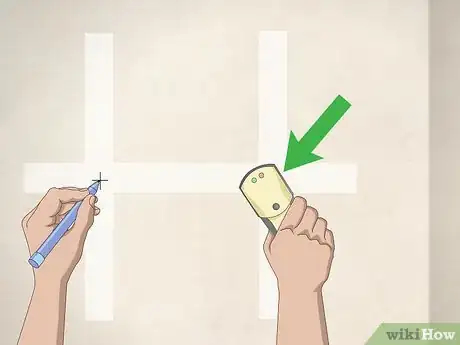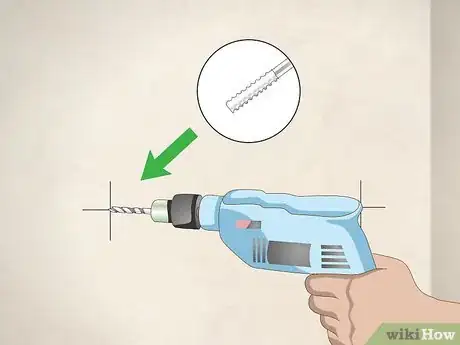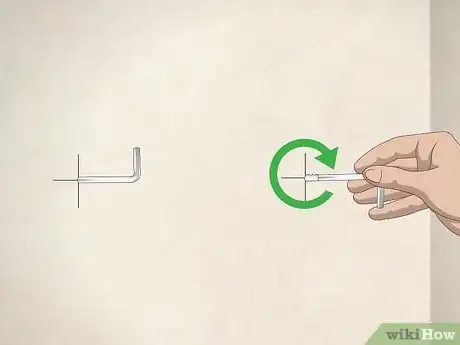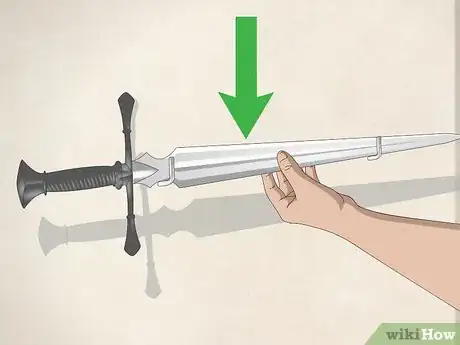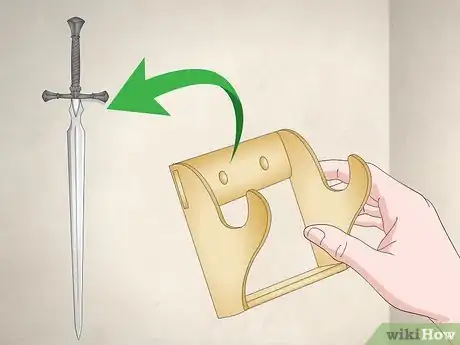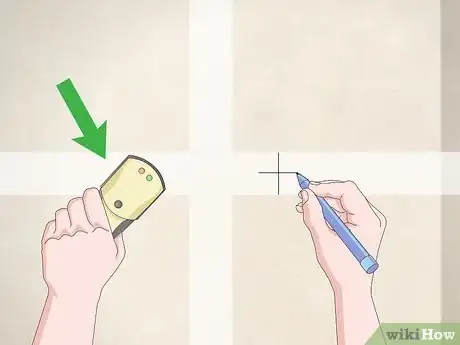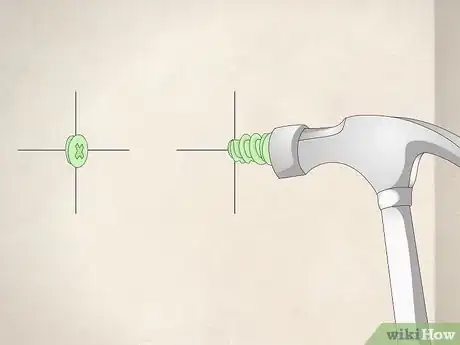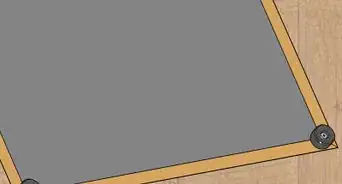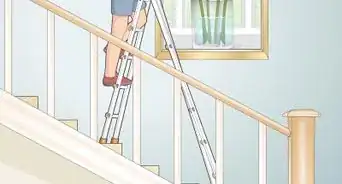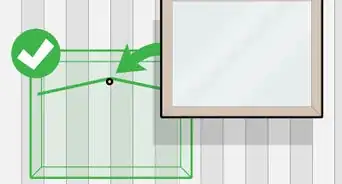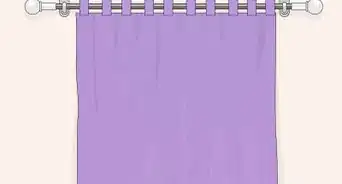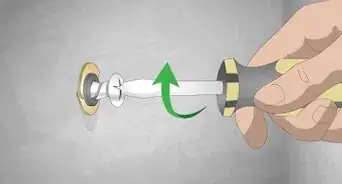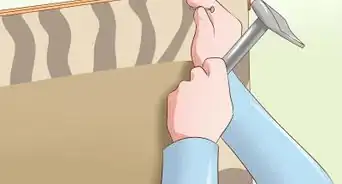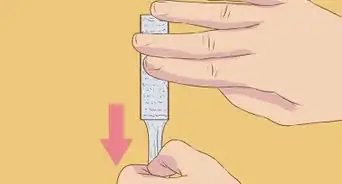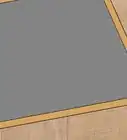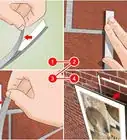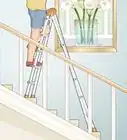This article was co-authored by Jason Phillip. Jason Phillip is a handyman specializing in mounting and hanging objects onto walls. With over five years of experience professionally mounting and installing objects through his company, Jason's Handyman Services, Jason's work includes working with mounting window AC units, designing art gallery walls, installing kitchen cabinets, and replacing light fixtures on drywall, brick, and plaster. He has been rated a "Top Pro" every year since 2016 by Thumbtack for being one of the highest-rated, most popular professionals on Thumbtack.
There are 16 references cited in this article, which can be found at the bottom of the page.
This article has been viewed 85,168 times.
Hanging swords on the wall is a great way to show off your sword collection. If you want to hang a sword, you'll need to decide its placement and choose whether to hang it vertically or horizontally. Then, you'll have to locate the studs in your wall or use drywall anchors to install hooks or hangers to hang them.
Steps
Using Hooks to Hang Your Sword Horizontally
-
1Buy stainless steel L or cup hooks to hang your swords horizontally. Hooks made specifically to hang swords will typically have a plastic covering over the hooks to prevent oxidation. You can also purchase multi-use hooks from a hardware store, as long as they are made of stainless steel.[1]
- You can buy sword-specific mounting hooks online.
- Some hooks will have threaded ends that you screw directly into the wall while others will have separate screws.
-
2Mark the ideal sword placement on your wall. Hold the sword horizontally against the wall and choose the location and orientation that you like the best. Once you find your desired location, mark the tip and end of the sword on the wall with a pencil.
- If you want your sword to be the focal point of the room, hang it in the center of your wall.
- If you're hanging several swords, make sure to place them an even distance apart so that they look uniform.
Advertisement -
3Mark 2 studs on the wall with a stud finder. One stud will support the hook that will hold up the end of your blade and the other stud will hold up the blade near the handle of the sword. Turn on your stud finder and drag it across the surface of your wall. Wait for the indicator light to flash or your stud finder to beep. Draw an X on each of the 2 studs with a pencil to mark them.[2]
- Hold the sword up against the wall to see where the hooks will be in relation to the sword.
- You may have to skip a stud or 2 if you are hanging a long sword.
- Use a level to draw a line connecting the marks to ensure that you’re hanging your sword straight.
- If you can't find a stud, use a wall anchor made for the wall material in your room.[3]
-
4Use a screwdriver to install hooks that have separate screws. Line the screw holes in the cup or L hooks with one of the marks that you created. Use a screwdriver or drill to drive the screw through the hole in the hook and into the stud in the wall. Continue turning the screw until the hooks are installed tightly on the wall and the plate on the hooks run flush with the head of the screw. Repeat the process on the other hook.[4]
-
5Use a drill bit to create a pilot hole if the end of your hooks are threaded. If your hooks have threaded ends instead of a plate and screw, you’ll have to pre-drill the holes for the hooks.[5] Use a drill bit that’s smaller than the end of your hooks. Then, hold the drill bit tip against the mark that you made, press the trigger on the drill, and apply forward pressure against the wall.[6]
-
6Screw the end of the hooks in if you’re using threaded hooks. Push the end of the hooks into the pilot holes that you created and make sure they are straight. Then, turn the hooks clockwise to tighten them into the pilot holes. Continue rotating the hooks until you can’t see the threads anymore. Once you're done screwing in the hook, it should be pointed upward so that it can support your sword.[7]
-
7Place your sword on top of the hooks. You can hang your sword with or without the sheath when hanging them on hooks. Place the end of the blade near the handle on one hook and the tip of the blade on the other hook. You’ve now successfully hung your sword using hooks.[8]
Hanging Vertically or Diagonally with Hangers
-
1Purchase wall hangers to display your swords vertically or diagonally. Sword wall hangers are made specifically to hang swords on walls and can be purchased online. These hangers support the pommel, or end of the handle, rather than the blade itself. Read the product description to make sure that the hanger is the right size for your style of sword.[9]
- Larger, heavier swords like a claymore or bastard sword require larger hangers.
- A smaller hanger is sufficient for smaller swords like a katana or sabre.
- The product description should have the maximum sword weight that can be held up by your hanger.
- You can weigh your sword on a scale or read the product description, which will usually have the sword's weight details.
- Most sword-specific hangers will enable you to hang your sword both vertically and diagonally.
-
2Use a stud finder to locate a stud in the wall. If you aren't using drywall anchors, you'll want to secure your hanger to a stud in your wall. Turn on your stud finder and drag it across the surface of the wall until it beeps or the light changes color. Mark the wall with a pencil at the top and bottom of where you want to hang your sword.[10]
- You may have to hold your sword up against the wall again to see what it will look like.
-
3Screw the mount into the wall with a drill. Line the screws up with the holes in the mount and use a drill to drive the screws into the stud. Continue rotating the screws until they run flush with the hanger bracket.[11]
- If you are hanging your sword diagonally, tilt the hanger in the direction that you want to the sword to point in before screwing it in.
-
4Hang your sword on the hanger. Hang the sword so that the pommel, or end of the handle, rests on top of the sword hanger. Most hangers can be adjusted to be smaller or larger, depending on the sword that you’re trying to hang.[12]
- If your sword is loose, take the sword off of the hanger and tighten the screws in the hanger.
Using Drywall Anchors
-
1Get drywall anchors instead of drilling into your studs.[13] If you have metal studs or want to hang your sword where there aren't any studs, you can use drywall anchors to attach your mount to the drywall. Purchase anchors that will fit the size screw that came with your wall hanger or hooks.[14]
- Drywall anchors can be bought online or at a hardware store.
- If your sword is heavier than 40 pounds (18 kg), you should screw the mount directly into studs rather than using anchors.[15]
-
2Hold the mount against the wall and mark the location. Hold the mount where you want to hang the sword and mark the screw holes with a pencil or create an indent with a screw. This will let you know where you need to make the holes for your drywall anchors.[16]
- If you are hanging your sword diagonally, hold the mount on an angle as you mark it.
- You can use the drywall anchors to hang your sword vertically, horizontally, and diagonally.
-
3Drill holes where you marked the wall. Read the product description to determine which size drill bit you should use. Hold the drill firmly against the wall where you marked, then carefully press the trigger and keep the drill as straight as possible as you drill through the drywall.[17]
-
4
-
5Screw the mount into the drywall anchors. Drywall anchors will essentially work as a replacement for studs and will keep your sword hung securely on the wall. Screw the hooks or mount screws into the anchors to secure the mount.
- You can use drywall anchors to attach both hooks and hangers.
Things You'll Need
Using Hooks
- Stud finder
- Cup or L hooks
- Drill
- Pencil
- Screws
- Level (optional)
Hanging Your Sword with Hangers
- Stud finder
- Drill
- Pencil
- Sword hanger
- Screws
Using Drywall Anchors
- Drill with drill bit
- Drywall anchors
- Hammer
References
- ↑ https://youtu.be/dp5FP8nFOuw?t=42s
- ↑ https://youtu.be/rzYkyBsYXA0?t=1m17s
- ↑ Jason Phillip. Handyman. Expert Interview. 2 July 2020.
- ↑ https://youtu.be/dp5FP8nFOuw?t=1m10s
- ↑ Jason Phillip. Handyman. Expert Interview. 2 July 2020.
- ↑ https://youtu.be/hVmrrooyIUw?t=23s
- ↑ https://youtu.be/hVmrrooyIUw?t=34s
- ↑ https://youtu.be/dp5FP8nFOuw?t=34s
- ↑ https://youtu.be/dVCy4E9pwOA?t=27s
- ↑ https://youtu.be/dVCy4E9pwOA?t=2m52s
- ↑ https://youtu.be/dVCy4E9pwOA?t=5m50s
- ↑ https://youtu.be/dVCy4E9pwOA?t=6m33s
- ↑ Jason Phillip. Handyman. Expert Interview. 2 July 2020.
- ↑ https://youtu.be/dVCy4E9pwOA?t=4m52s
- ↑ https://www.todayshomeowner.com/testing-wall-anchors-and-picture-hangers/
- ↑ https://youtu.be/dVCy4E9pwOA?t=4m4s
- ↑ https://youtu.be/dVCy4E9pwOA?t=4m33s
- ↑ Jason Phillip. Handyman. Expert Interview. 2 July 2020.
- ↑ https://youtu.be/dVCy4E9pwOA?t=4m56s


